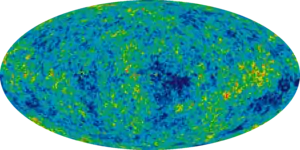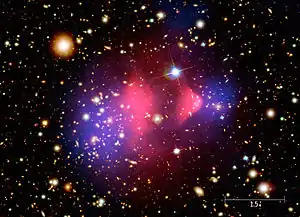Light dark matter
Light dark matter, in astronomy and cosmology, are dark matter weakly interacting massive particles (WIMPS) candidates with masses less than 1 GeV.[1] These particles are heavier than warm dark matter and hot dark matter, but are lighter than the traditional forms of cold dark matter, such as Massive Compact Halo Objects (MACHOs). The Lee-Weinberg bound [2] limits the mass of the favored dark matter candidate, WIMPs, that interact via the weak interaction to GeV. This bound arises as follows. The lower the mass of WIMPs is, the lower the annihilation cross section, which is of the order , where m is the WIMP mass and M the mass of the Z-boson. This means that low mass WIMPs, which would be abundantly produced in the early universe, freeze out (i.e. stop interacting) much earlier and thus at a higher temperature, than higher mass WIMPs. This leads to a higher relic WIMP density. If the mass is lower than GeV the WIMP relic density would overclose the universe.
| Part of a series on |
| Physical cosmology |
|---|
 |
|
Some of the few loopholes allowing one to avoid the Lee-Weinberg bound without introducing new forces below the electroweak scale have been ruled out by accelerator experiments (i.e. CERN, Tevatron), and in decays of B mesons.[3]
A viable way of building light dark matter models is thus by postulating new light bosons. This increases the annihilation cross section and reduces the coupling of dark matter particles to the Standard Model making them consistent with accelerator experiments.[4][5][6]
Motivation
In recent years, light dark matter has become popular due in part to the many benefits of the theory. Sub-GeV dark matter has been used to explain the positron excess in the galactic center observed by INTEGRAL, excess gamma rays from the galactic center [7] and extragalactic sources. It has also been suggested that light dark matter may explain a small discrepancy in the measured value of the fine structure constant in different experiments.[8]
See also
References
- Cassé, M.; Fayet, P. (4–9 July 2005). Light Dark Matter. 21st IAP Colloquium "Mass Profiles and Shapes of Cosmological Structures". Paris. arXiv:astro-ph/0510490. Bibcode:2006EAS....20..201C. doi:10.1051/eas:2006072.
- Lee B.W.; Weinberg S. (1977). "Cosmological Lower Bound on Heavy-Neutrino Masses". Physical Review Letters. 39 (4): 165–168. Bibcode:1977PhRvL..39..165L. doi:10.1103/PhysRevLett.39.165.
- Bird, C.; Kowalewski, R.; Pospelov, M. (2006). "Dark matter pair-production in b → s transitions". Mod. Phys. Lett. A. 21 (6): 457–478. arXiv:hep-ph/0601090. Bibcode:2006MPLA...21..457B. doi:10.1142/S0217732306019852. S2CID 119072470.
- Boehm, C.; Fayet, P. (2004). "Scalar Dark Matter candidates". Nuclear Physics B. 683 (1–2): 219–263. arXiv:hep-ph/0305261. Bibcode:2004NuPhB.683..219B. doi:10.1016/j.nuclphysb.2004.01.015. S2CID 17516917.
- Boehm, C.; Fayet, P.; Silk, J. (2004). "Light and Heavy Dark Matter Particles". Physical Review D. 69 (10): 101302. arXiv:hep-ph/0311143. Bibcode:2004PhRvD..69j1302B. doi:10.1103/PhysRevD.69.101302. S2CID 119465958.
- Boehm, C. (2004). "Implications of a new light gauge boson for neutrino physics". Physical Review D. 70 (5): 055007. arXiv:hep-ph/0405240. Bibcode:2004PhRvD..70e5007B. doi:10.1103/PhysRevD.70.055007. S2CID 41227342.
- Beacom, J.F.; Bell, N.F.; Bertone, G. (2005). "Gamma-Ray Constraint on Galactic Positron Production by MeV Dark Matter". Physical Review Letters. 94 (17): 171301. arXiv:astro-ph/0409403. Bibcode:2005PhRvL..94q1301B. doi:10.1103/PhysRevLett.94.171301. PMID 15904276. S2CID 20043249.
- Boehm, C.; Ascasibar, Y. (2004). "More evidence in favour of Light Dark Matter particles?". Physical Review D. 70 (11): 115013. arXiv:hep-ph/0408213. Bibcode:2004PhRvD..70k5013B. doi:10.1103/PhysRevD.70.115013. S2CID 119363575.
Further reading
- Bertone, Gianfranco (2010). Particle Dark Matter: Observations, Models and Searches. Cambridge University Press. p. 762. Bibcode:2010pdmo.book.....B. ISBN 978-0-521-76368-4.
